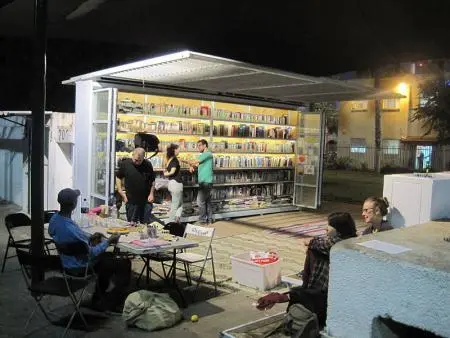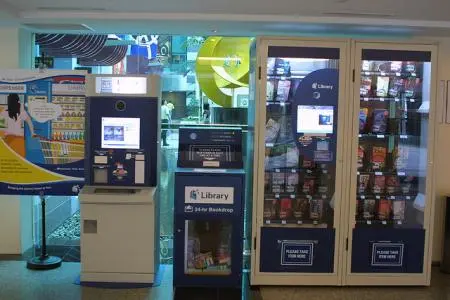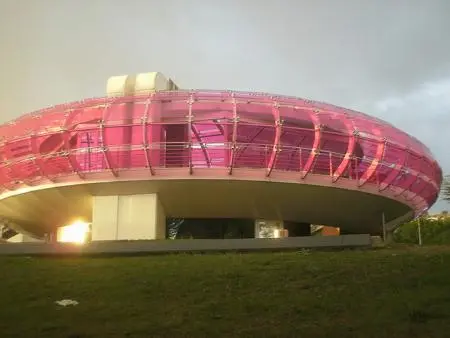Originally posted 4/16/2013
Let's do a word association exercise. When I say "books, borrowing, building..." you'd say, "library." Great. We're off to a good start. Let's try again: "Donkey, tank, phone booth, UFO..." Anybody? No, it has nothing to do with donkey versus alien combat. This one's a little tougher. Okay, I'll give it to you. The answer, once again, is "library." See, although the libraries most of us visit on the regular are dull municipal buildings that we'd avoid were they not full of thousands of free books, some communities have fanciful architectural wonders, animals who deliver books to children, repurposed phone booths full of reading material on the street, and other wonderfully unexpected ways of bringing reading to the people. In honor of National Library Week, let's take a look at ten of these brilliant spaces...
Photo credit: Itzuvit
1. The Biblioburro: Delivering Books Via Donkey
Let's start with the Biblioburro. He's top of our list because, have you seen how adorable baby donkeys are? Oh, and because he brings books to children who wouldn't otherwise have access to them. Luis Soriano—a primary school teacher who runs the Biblioburro program in his spare time—loads his donkeys, Alfa and Beto, full of books then travels up to four hours one way to visit villages in rural Colombia. Once there, he reads to the young people, helps them with homework, and loans them books from his mobile library. Soriano told CNN that he got the idea back in 1990 because he had "two unemployed donkeys at home," and we all know there's nothing worse than having slack-ass donkeys hanging out, playing video games, and eating all the Cheetos. The Biblioburro has brought literacy and the joy of reading to an estimated 4,000 kids so far, which makes Soriano's tales of breaking his leg in a donkey fall and getting tied to a tree by bandits seem worth it.
Photo credit: Itzuvit
2. The Levinski Garden Library: Cataloging Emotional History
Designed to serve refugees and migrant workers in Israel, The Levinski Garden Library is an outdoor facility with books in fifteen languages, located in the Tel Aviv park where those populations gather. There are no walls, doors, or guards. Its two illuminated shelves—one for adults and a shorter one for kids—provide a welcoming glow throughout the night while a large canopy protects the tomes from weather and gives visitors shelter while they browse the library's 3,500 books. The books, which range from bestsellers to graphic novels to classic literature, are arranged not by author, genre, or Dewey Decimal system, but by the emotions they elicit. Every book asks the reader to describe it as amusing, bizarre, boring, depressing, exciting, inspiring, or sentimental. Each emotion is color coded, and each reader's response is permanently recorded in the form of colored tape reflecting their reaction to the book, which is re-shelved according to the most recent reaction. The library's site explains that "the books wander between the shelves as their readers have wandered/are wandering the world. They carry with them their emotional history." There'd have to be nothing worse as a writer than visiting the library and finding 80 pieces of "boring" color-coded tape attached to your work.
Photo credit: Carlos Adampol
3. Arma de Instruccion Masiva (Weapon of Mass Instruction): Attacking With Knowledge
Aside from being a ridiculously ugly car, the Ford Falcon doesn't have any negative connotations to most of the world. But in Argentina, the car represents a dark time in the nation's history. It was driven by the army as well as the secret police and anti-communist death squads during the country's military junta dictatorship. Artist Raul Lemesoff has taken a 1979 Falcon and transformed it from a symbol of fear to a mobile library in the shape of a tank. Lemesoff cruises the streets of both Buenos Aires and smaller towns that don't have access to traditional libraries. He pulls up beside pedestrians and bikers in his impossible-to-miss tank-shaped library and offers them one of the 900 books perched on the vehicle's frame, which is much less creepy than offering ice cream or back rubs. He hopes to bring his knowledge attack (see what he did there?) to other nations soon.
Photo credit: Joe Gratz
4. Mechanical Libraries: Vending 24 Hours A Day
Nothing will replace the quiet rustle of pages, the smell of dusty tomes, or the knowledge of your friendly local librarian, but there are times when night owls like me would love to check out a book at 3am, so I'm not completely against library vending machines. Book vending machines have been around since the 1930s, but in recent years more and more libraries are taking advantage of them, placing them on busy streets, at train stations, and in shopping centers. Early numbers from Contra Costa County in California suggest that the convenience of the machines increased circulation by around 8 percent, putting an additional 600,000 books into patrons hands during the machines' first year. In one Beijing district, the machines account for 31.6 percent of books borrowed. Even if you're fighting the good fight against our machine overlords, you've got to admit that anything that increases the number of books the public reads can't be all bad. And it's still nowhere near as depressing as a bookless library.
Photo credit: Perugia-City.com
5. Biblioteca Sandro Penna: Terrifying Alien Abductees Since 2004
Not far from the city of Perugia's medieval aqueducts, historic fountains, classical arches, and exquisite cathedrals sits a bubble-gum pink saucer that looks like a UFO created by Hello Kitty. It is, however, not transporting alien kittens to central Italy (bummer) but rather providing library services for the people of Perugia. The Biblioteca Sandro Penna, a public library named for poet Sandro Penna, features rose-colored glass walls that let sunlight in by day and emit a ruddy glow at night. Architect Italo Rota designed the three-story disc to look like a flying saucer. Because why not? Madman or creative genius? It's tough to say.
Photo credit: Anders
6. Epos Book Boat: Floating Books In The Fjords
When you're in the Norwegian fjords, you think to yourself, "How on earth do the people who live here get groceries in the winter?" Evidently they have that figured out, because there don't appear to be grocery boats that go from island to island. Library books, however, are another thing. A book boat called Epos travels to more than 250 small communities on islands in the fjords every year between September and April. On board, the vessel has about 6,000 books, a captain, a cook, a couple of librarians, and one or two vaguely titled "entertainers" (Clowns? Strippers? Contortionists? All three? What entertainment does one need most when snowed into their home for months on end?). In the summer, the floating library turns into a leisure cruise ferry. The service started in 1959 and is organized and paid for by the libraries of the three counties it serves.
Photo credit: Axel Brunst Photography
7. Stuttgart City Library: Putting The Focus On Books
The Stuttgart City Library looks like an Apple store designed by M.C. Escher. On the outside, it's a perfect cube whose walls align exactly with the four compass points. On the inside, it's pure white with sharp angles and a soaring five-story atrium surrounded by Escher-esque stairs and rectangular furniture. Since opening in 2011, the ultra-modern library—designed by Korean architect Eun Young Yi—has been praised as one of the world's most gorgeous libraries and disparaged for its harshness and sterility. The design lacks the coziness that some people look for in a library but the stark whiteness of the environment itself puts all the focus on the colorful books lining the shelves... and there's no denying it's beautiful.
Photo credit: BookAid.org
8. The Kenyan Camel Library: Serving Nomadic Populations
Lest you think mules are the only animals who can tote a library around on their backs, meet the library camels of Kenya (someone form an indie band and call it that, please). The camels carry both books and camping gear for the traveling librarians as they travel across the desert. The caravan visits people in nomadic communities where literacy rates can be as low as 15 percent due, in large part, to lack of access to reading materials. The Kenya National Library Service started the program in 1985 and has been sending caravans of book-toting hump-backed service animals across the desert ever since. The program already serves between 5,000 and 6,000 patrons. There's demand for expansion, but resources are limited. According to the BBC, all nine of the camels used are male. To get more camels, they obviously need at least one sexy lady camel. If you have one of those sitting around, please donate her to the cause.
Photo credit: Little Free Library
9. Micro Libraries: Transforming Objects Into Book Havens
You've probably heard of Little Free Libraries. Heck, you might even have one in your front yard and if you don't, you can fix that. The wooden boxes on poles are sprouting up everywhere. (Check this map to see if there's one near you.) In 2009, to honor his late mother, Todd Bol put a little wooden house full of books outside his house with a sign indicating that people should take or leave a book. Four years later, Publishers Weekly reports that there are as many as 6,000 of the tiny libraries in forty countries around the world. Around the same time Bol was erecting the first Little Free Library, the Brits were recycling their iconic red phone boxes into 24-hour mini libraries. Berlin created a book forest, cutting shelves into the trunks of fallen trees. The trees are grouped together on a city street and passersby can take or leave a book any time. These never-closed book-swapping spots take a lot of different forms, but they all spread the love of books and encourage the discovery of new authors.
Photo: Eneas De Troya
10. Vasconcelos Library: Entering The Matrix
Mexico City's 409,000-square-foot Vasconcelos Library is known as the Megabiblioteca (megalibrary), making it sound as much like Godzilla's arch nemesis as a haven for bibliophiles. Alberto Kalach, who designed the building after winning Mexico's first international architecture competition in more than a century, created a space that appears to have been taken straight out of a Matrix-inspired dream—with books on crystal shelves that seem to be suspended in mid-air, huge industrial steel fittings, and five grid-like levels with turquoise tinted glass floors. The 500,000 volumes overlook an open courtyard featuring enormous striped whale bones floating from the ceiling. Of course. The whole shebang is surrounded by a massive botanical garden.
Which is your favorite unusual library? Did we miss one that should've been on the list? Let us know!

About the author
Kimberly Turner is an internet entrepreneur, DJ, editor, beekeeper, linguist, traveler, and writer. This either makes her exceptionally well-rounded or slightly crazy; it’s hard to say which. She spent a decade as a journalist and magazine editor in Australia and the U.S. and is now working (very, very slowly) on her first novel. She holds a B.A. in Creative Writing and an M.A. in Applied Linguistics and lives in Atlanta, Georgia, with her husband, two cats, ten fish, and roughly 60,000 bees.

















